Types of Pistols: A Complete Beginner’s Guide

Thinking about buying your first pistol? Choosing any type of pistol can certainly feel overwhelming — no matter if you're aiming for personal defense, sport shooting, or simply expanding your collection. By the end of this guide, you'll have a clear understanding of what to look for in a pistol and so much more!
Key Takeaways
- Types of Pistols by Actions & Use Cases: Two of the most popular types of pistols are semiautomatic and break-action. The barrel length and size determine these categories.
- What Are the Most Popular Types of Pistols? 9mm semiautomatic pistols are widely popular and available. You’ll find plenty of handgun sizes for this caliber, too!
- Parts of a Pistol: The frame is foundational to the pistol, while the magazine stores the ammo. The slide loads the ammo. The barrel is where the bullet passes through.
- Pistol Sizes: Pistols are available in various sizes — competition, standard, compact, and slimline.
- Is a Revolver a Pistol? A revolver is not a pistol because it rotates ammo in a cylinder.
Types of Pistols by Actions & Use Cases
Head into any gun store, and you’ll encounter plenty of pistol types: each suited for specific purposes and/or use cases (like concealed carry). Differences in barrel length and size are key factors in categorizing pistols. Two of the most popular pistols are semiautomatic pistols & break-action pistols.
Semiautomatic pistols are the go-to choice for rapid firing without manual reloading.
For a classic feel, consider break-action pistols, which feature a unique hinged frame.
Semiautomatic Pistols
Semiautomatic pistols use recoil energy to eject spent shells, load new rounds, and efficiently prepare for the next shot. Two main types are single action (SA) pistols & striker-fired (SF) pistols.
Single Action (SA) Pistols: You need to cock the hammer manually for the first shot, making the trigger pull lighter and shorter. They're great for target shooting because of their precise and smooth trigger feel.
Striker-Fired (SF) Pistols: These don't have an external hammer but use a spring-loaded striker to fire. Their consistent trigger pull makes them reliable for law enforcement and self-defense.

Semiautomatic Pistols: What You Should Know
Semiautomatic pistols are reliable and user-friendly. The Ruger Security-9 9mm Luger Semiautomatic Pistol comes equipped with synthetic grips and a bladed trigger safety.
- Self-Defense: These pistols are commonly used for self-defense and can fire multiple rounds quickly. Many individuals rely on semiautomatic pistols for personal safety.
- Beginner-Friendly: They are lightweight and easy to use, making them suitable for beginners. Novice shooters often appreciate the simplicity and ease of handling semiautomatic pistols.
Break-Action Pistols
Break-action pistols have a hinge that lets the barrel open for easy loading, much like break-action shotguns. Key points about them include:
Versatile Cartridge Compatibility: They can use different types of cartridges — from rifle and pistol to revolver cartridges and even shotgun shells. This versatility makes them adaptable to various shooting preferences.
User-Friendly Design: Their design makes them easy to load and unload, ideal for beginners. They're commonly used in single-shot pistols, focusing on simplicity and ease of use.
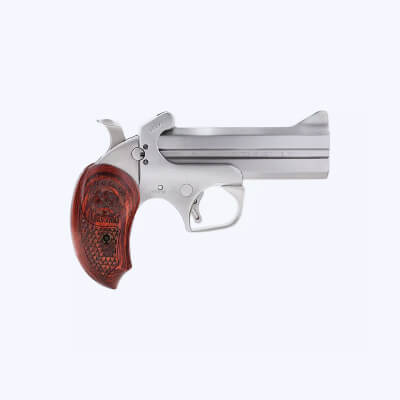
Common Break-Action Pistols Features
Break-action pistols are versatile firearms suitable for hunting and self-defense. The Bond Arms Snake Slayer IV .45 LC Break-Action Pistol boasts a double barrel design and a 2-round capacity.
- Loading and Unloading: Break-action pistols are easy to load and unload. Some break-action models open from the top, while others utilize different mechanisms.
- Limited Firepower and Reload Speed: Break-action pistols can have limited firepower and slower reload times than other pistol types. Shooters should consider these factors when choosing a firearm for specific purposes.
What Are the Most Popular Types of Pistols?
The most popular types of pistols are semiautomatics and single-shots. Informally, revolvers are another popular option. However, revolvers are technically classified as handguns — NOT pistols.
Popular Semiautomatic Pistols Types & Models
When picking a pistol, semiautomatics are often the go-to choice for their efficiency and ease of use blend. The 9 mm pistols shine as a top pick, balancing power and practicality. The GLOCK 19X boasts a 17-round cartridge capacity in a sleek, semiautomatic design. Whether for personal defense or professional scenarios, it delivers performance enthusiasts, and experts can appreciate.
Striker-Fired Semiautomatic Pistols
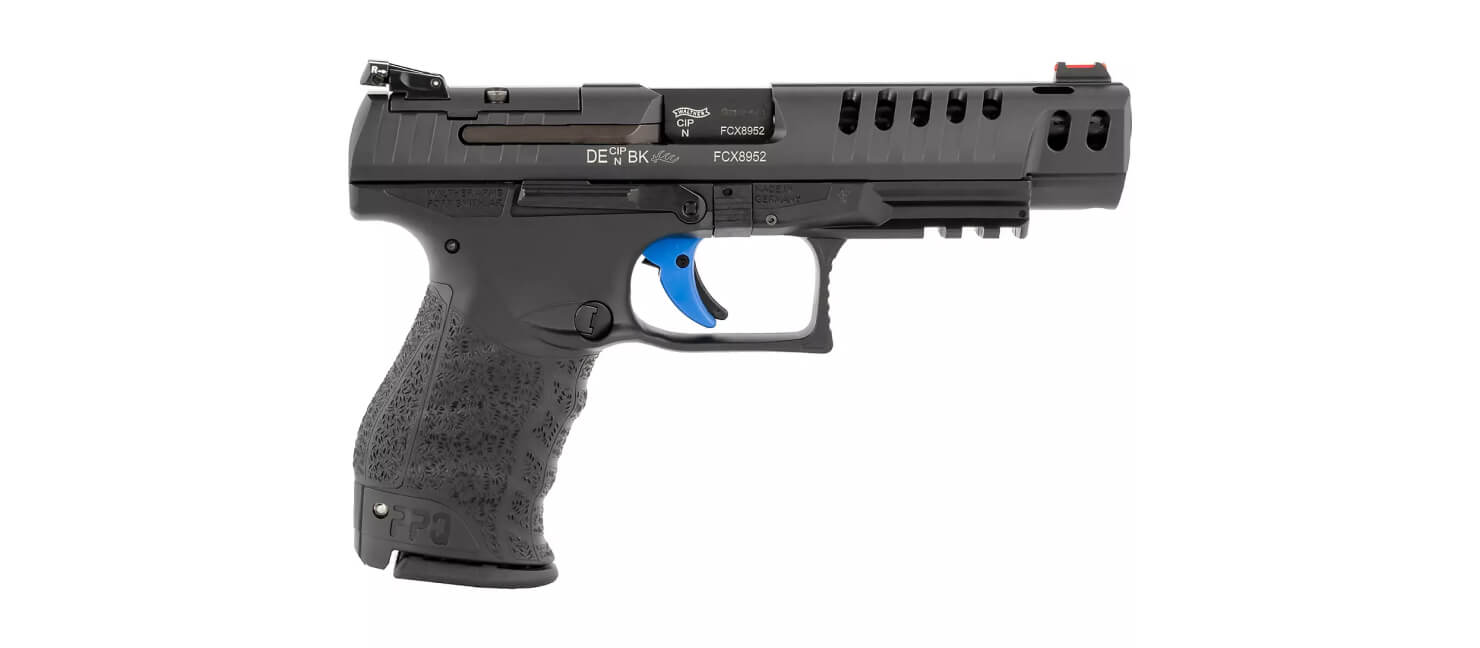
Shooters often prefer striker-fired semi-automatic pistols. Racking the slide inserts a round into the chamber and cocks a spring-loaded striker. Pulling the trigger, then fully cocks the spring and fires the round.
Easy Assembly & Breakdown: Striker-fired handguns don’t traditionally have an exhaustive, complicated assembly process. Disassemble them for cleaning/maintenance, and reassemble them with ease.
Quick and Intuitive Learning Curve: Beginners often prefer these pistols due to their straightforward operation, which leads to a quicker and more intuitive learning curve.
Faster Reset for Follow-Up Shots: They often have a quicker trigger reset, which enables shooters to take quicker follow-up shots while maintaining better control over the firearm.
Hammer-Fired Semiautomatic Pistols
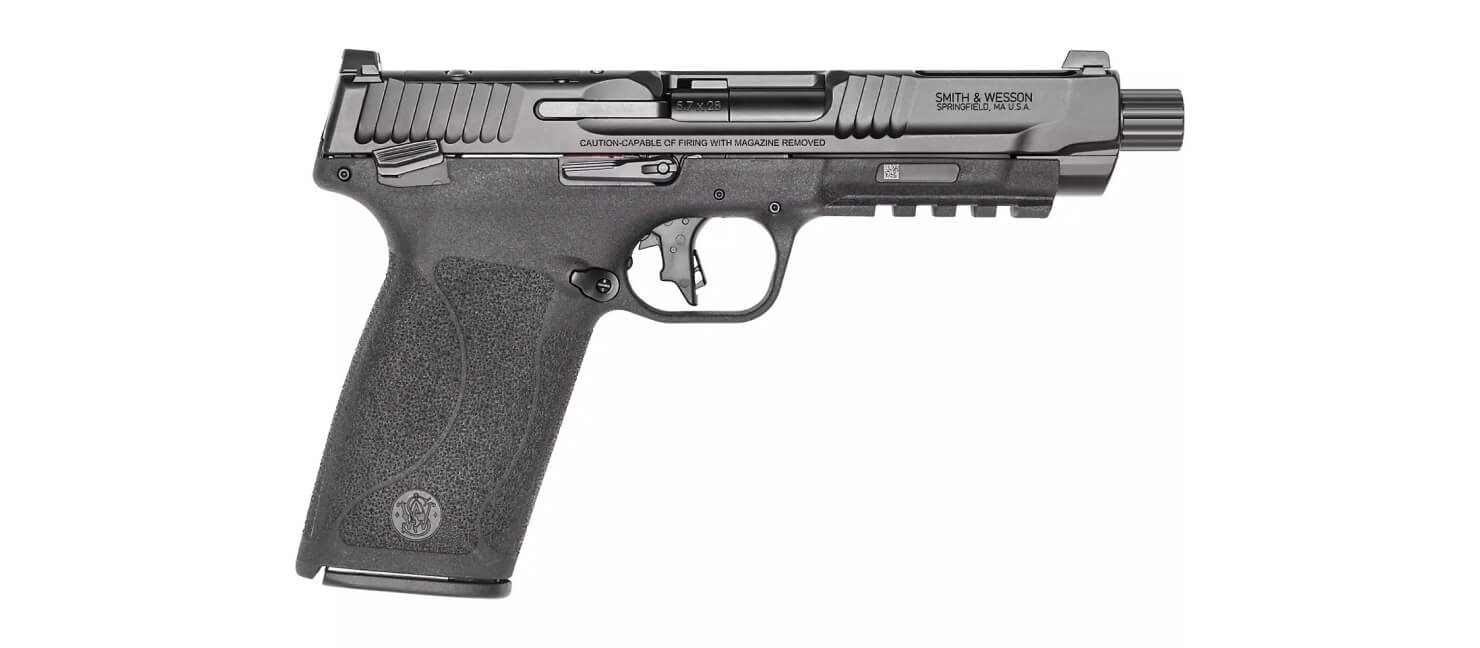
Semi-automatic pistols feature hammers that are spring-rotated. During this rotation, the hammer makes contact with the firing pin, which then strikes the primer.This fires off a round. Shooters can easily determine whether the hammer is fully cocked. This design can be classified into three types as described below:
Single Action: On a single action, pulling the trigger releases the hammer, it doesn't cock it. This action takes place when a shooter cycles the slide to chamber a round. After firing, the next round is cycled, and the hammer is re-cocked.
Double Action Only: The trigger of a double action pistol has a dual function, as it both cocks and releases the hammer. After a shooter fires a round, the hammer resets to its decocked position.
Double Action/Single Action: The shooter can switch between a single action and double action pull. Shooters can take their first shot in double-action mode and then switch to single-action pulls.
Popular Single-Shot Pistols Types & Models
Single-shot pistols are designed to fire one round at a time and do not have automatic reloading capabilities. Shooters must manually reload these pistols after each shot. They are often considered beginner-friendly and easy to use.
Derringers & Break-Action Pistols
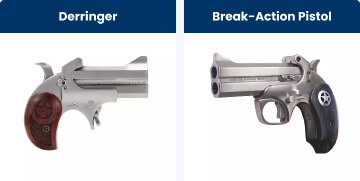
Derringers are break-action firearms that can hold only one round at a time. This means the shooter needs to manually open the action and load a single round into the chamber. .22 LR ammunition is commonly used with these firearms.
Parts of a Pistol
To understand how a pistol works, you need to understand its main parts: the frame, barrel, slide, and magazine. These parts all have important jobs that make the pistol function well.
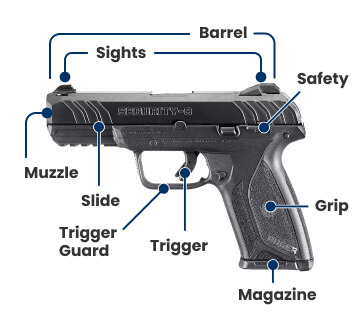
Frame: The frame is like the body of the pistol, holding all the parts together. It includes the grip and trigger guard, making up the pistol's structure.
Barrel: The barrel is a tube where the bullet goes through. Longer barrels make bullets go faster and shoot more accurately.
Slide: The slide is at the top of semi-automatic pistols. It helps with recoil, loads and unloads ammo, and smooths firing.
Magazine: The magazine stores bullets and lets you reload quickly. It's essential for continuous shooting.
Pistol Sizes
Handguns offer a range of sizes. You might prefer a competition pistol for sports shooting or a subcompact for concealed carry. Take a look at the various pistol sizes outlined in our table below.
| Pistol Sizes | |
|---|---|
| Pistol Size | Description |
| Longslide | Longslides feature extended barrels and slides, typically providing improved accuracy and recoil control. They are often used in competition shooting or for long-range target practice. |
| Competition | Competition pistols are designed for precision shooting sports and feature features like adjustable sights, tuned triggers, and often come in full-size configurations for enhanced control. |
| Standard | Standard-sized pistols strike a balance between size, capacity, and ease of concealment. They are versatile and suitable for various purposes, including self-defense and concealed carry. |
| Compact | Compact pistols are smaller and more easily concealed than standard-sized models. They sacrifice some capacity for improved concealability, making them ideal for concealed carry. |
| Subcompact | Subcompact pistols are even smaller and more concealable than compacts. They are highly portable and often favored for deep concealment or backup roles. |
| Slimline | Slimline pistols prioritize a slim profile for easier concealment. They often feature single-stack magazines and are chosen for discreet carry. |
| Crossover | Crossover pistols blend the characteristics of full-sized and compact models, offering a balance between capacity, concealability, and control. They are versatile and suitable for various applications. |
Is a Revolver a Pistol?
No, a revolver is not a pistol. Both revolvers and pistols are handguns, yet they have different designs. A pistol stores ammunition in a magazine, whereas a revolver rotates ammunition in a cylinder.This design allows pistols to fire semi-automatically. With their rotating cylinders, revolvers do not meet the technical definition of a pistol.
Have Fun Out There!
Set to take on a wild hog with your pistol? Discover our extensive range of centerfire pistols and optics-ready handguns tailored to elevate your hunting experience. Explore top brands like Browning and GLOCK, and ensure you're well-equipped with our selection of ammo. Gear up now and get ready for a successful hunt.


